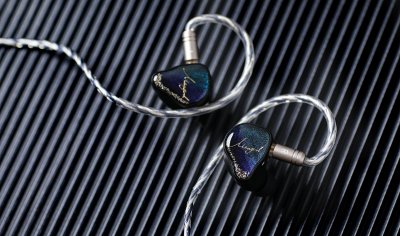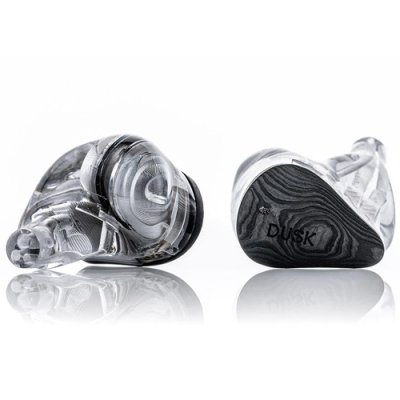Xenns Tea Pro and Moondrop x Crinacle Dusk use 2DD+6BA and 2DD+2BA+2PLA driver setups respectively. Xenns Tea Pro costs $359 while Moondrop x Crinacle Dusk costs $400. Moondrop x Crinacle Dusk is $41 more expensive. Moondrop x Crinacle Dusk holds a slight 0.2-point edge in reviewer scores (7.5 vs 7.7). User ratings place Xenns Tea Pro at 8 and Moondrop x Crinacle Dusk at 7.7. Xenns Tea Pro has better bass with a 0.7-point edge, Moondrop x Crinacle Dusk has significantly better dynamics with a 1-point edge and Moondrop x Crinacle Dusk has better soundstage with a 0.5-point edge.
Insights
| Metric | Xenns Tea Pro | Moondrop x Crinacle Dusk |
|---|---|---|
| Bass | 8 | 7.3 |
| Mids | 7.3 | 7.4 |
| Treble | 7.7 | 7.8 |
| Details | 7.5 | 8 |
| Soundstage | 7 | 7.5 |
| Imaging | 7.5 | 7.5 |
| Dynamics | 6 | 7 |
| Tonality | 7.3 | 7.5 |
| Technicalities | 7.2 | 8 |
Xenns Tea Pro Aggregated Review Score
Average Reviewer Scores
Average Reviewer Score:
7.5Strongly Favorable
Moondrop x Crinacle Dusk Aggregated Review Score
Average Reviewer Scores
Average Reviewer Score:
7.7Strongly Favorable
Reviews Comparison
Xenns Tea Pro reviewed by Bad Guy Good Audio
Youtube Video Summary
Xenns Tea Pro lands as a confident mid-tier contender with a 2DD+6BA setup around $350–360, going head-to-head with sets like DaVinci, Estrella, and Dusk. Sub-bass has real grunt—808 drops, the 38 Hz hit on Big Boi’s “Kill Jill,” and early-2000s hip-hop cues slam with authority yet stay controlled. Electric-bass lines have clean pluck and release, avoiding mid-bass bloom, so the low end never muddies male or female vocals; the tuning plots close to a favored target without sounding sterile.
The midrange keeps vocals center and natural—no husky haze from mid-bass, no shout from upper-mids—and treble carries harmonics without tizzy edge, handling tricky voices (think Neil Young, Elton John, Jim Croce) with ease. Fans of the Moondrop Variations’ leaner, drier 3 kHz-pushed profile may find the Tea Pro richer and less “etched,” but that extra body reads as musical rather than bloated. Crucially, the BAs avoid that metallic tinge, giving cymbals and keys a clean, pleasing sheen.
On balance, this is the kind of tuning that competes directly with its peers—and depending on priorities, arguably beats them. With punchy sub-bass, stable mids, smooth but detailed top end, and zero fatiguing quirks, the Tea Pro sits between a firm “would buy” and a potential “shameless hype” slot—prime material for renewed top-five shortlists now that the market has cooled.
Bad Guy Good Audio original ranking
Bad Guy Good Audio Youtube ChannelBuy Xenns Tea Pro on Linsoul
Ad
Price: $359
Buy Xenns Tea Pro on Linsoul
Moondrop x Crinacle Dusk reviewed by Bad Guy Good Audio
Bad Guy Good Audio original ranking
Bad Guy Good Audio Youtube ChannelBuy Moondrop x Crinacle Dusk on Aliexpress
Ad
Price: $399
Buy Moondrop x Crinacle Dusk on Aliexpress
Xenns Tea Pro reviewed by
 Fresh Reviews
Fresh Reviews
Youtube Video Summary
Build & presentation scream premium: a matte metal alloy shell with lush green-blue fade and gold script, plus a black-silver sparkle faceplate that looks like wearable art. Ergonomics are excellent despite a slightly wider nozzle and a bit of heft, allowing long sessions without discomfort. The package impresses with a gallery-style unboxing, matching carrying case, and a silver cable with interchangeable 3.5/4.4 terminations. Under the hood: 2 dynamic drivers + 6 BAs at ~$360.
Tonally it’s a balanced, warmer-leaning set with elevated sub-bass depth, clean attack/decay, and more treble extension and sparkle than comparable sets. The stage sits a touch more intimate, but separation and layering are immaculate, and imaging locks in with precision. Mids don’t pop as forward as some peers, yet overall resolution stays high with “oodles of detail,” giving music a rich, cohesive presentation that still feels highly detailed.
For competitive play the performance is A-tier: in Apex, Valorant, and especially Call of Duty, imaging and depth perception are master-class. Gunfire comes through cleaner with less reverb; airstrikes and mortar noise get pushed back so crucial cues like footsteps, slides, and shield pops cut through. The more intimate stage aids crosshair placement and micro-positioning, while separation stays clear even in chaotic fights. Verdict: a high A- on the Wall-Hack Certified list—an excellent pick for gamers wanting warmth, sub-bass authority, and elite imaging without sacrificing musical enjoyment.
Fresh Reviews original ranking
Fresh Reviews Youtube Channel
Moondrop x Crinacle Dusk reviewed by
 Fresh Reviews
Fresh Reviews
Youtube Video Summary
Moondrop x Crinacle Dusk earns raves for music: a clean, textured, fast low end with real sub-bass punch that avoids bloat, a natural, resolving midrange for male/female vocals and instruments, and crisp, well-controlled treble that delivers cymbal air without harshness. The overall presentation feels well-rounded and technical enough to spar with sets far above its price, evoking “revisit the whole library” vibes. Build and comfort impress too—lightweight shell, transparent chassis with a wood-like carbon faceplate, and an ergonomic fit. Tip-rolling matters: Spring Tips add a touch of openness and air, while SpinFit W1 tightens stage and teases out more bass on the “fish-mouth” nozzle.
Accessories are solid: a standard 3.5 mm cable plus a USB-C DSP cable that’s great for Android/iPad on-the-go listening, though PC gaming revealed instability in some titles (stutters/freezes in Apex Legends and Call of Duty). Day to day, the cable’s braid resists tangles, and the included case/tips round out a tidy package.
For competitive play, performance is mixed. Imaging is good and the bass gives an immersive punch, but the stage skews intimate and heavy effects can mask subtle cues. In Apex Legends, verticality and depth perception suffer—overhead action blends at forehead level, distant slides/grass shuffles fade, and chaotic fights cause layering to mush before quickly recovering. Call of Duty shows similar trade-offs with aerial and fine details under bombardment, while Valorant fares best thanks to tighter maps and fewer simultaneous effects (though horizontal peeks and micro-depth could still be sharper). The takeaway: S-tier for music in this bracket and a fun, cinematic gamer, but not the most surgical pick for top-ranked competitive play.
Fresh Reviews original ranking
Fresh Reviews Youtube ChannelXenns Tea Pro reviewed by Jays Audio
Youtube Video Summary
The Xenns Tea Pro stands as the most refined and well-rounded iteration of the Tea series to date, offering strong competition in the $300 IEM market. While it loses some of the unique "sauce" found in earlier models, it delivers significant improvements, particularly sounding like a "better Da Vinci" with its bass presentation. The Pro features a similar heaviness and thickness to the notes but adds more upper mids, treble extension, and overall better resolution. For roughly $60 more than the Da Vinci, the Pro offers upgraded drivers from Knowles, contributing to better timbre, a bump in technical performance, and equally good accessories.
Compared to the original Tea and Tea 2, the Pro emerges as the better all-rounder but lacks their distinct character. The original Tea remains superior for its highly addicting vocals, bite, and holographic staging, while the Pro offers more balanced, fuller, smoother, and more versatile vocals alongside superior bass in slam, texture, impact, resolution, and rumble due to its new dual dynamic drivers. Treble extension, overall resolution, and a more open stage also see noticeable improvements over both predecessors. Technical performance-wise, the Pro is highly competitive with other $200+ IEMs, offering better resolution, imaging, transience, attack, and separation than the Da Vinci, along with a more natural sound.
Positioned under $400, the Tea Pro fits as a balanced choice between neutral and exciting tunings. Against the clean, neutral Pilgrim or Dusk, the Pro provides a bassier, heavier, fuller sound with more forward vocals and better note weight. Compared to the exciting Estrella, the Pro is more balanced, thicker, and slams harder, while the Estrella offers more dynamic contrast and crispier treble. Versus the similarly priced Hype 4, the Pro delivers harder slam, deeper bass, and sharper vocals with more bite, though the Hype 4 is slightly quicker, smoother, and more balanced. Essentially, the Tea Pro excels as a versatile, resolving set with satisfying bass and well-tuned vocals, making it the best pick for most listeners despite losing some quirks of earlier models.
Jays Audio Youtube Channel
Moondrop x Crinacle Dusk reviewed by Jays Audio
Youtube Video Summary
Stock tuning lands in the safe-and-smooth lane: a gently warm balance with a slight treble emphasis, nothing egregious and nothing especially standout. It works well for J-pop/K-pop at mid volume thanks to tamed upper-mids that keep sibilance in check. The trade-off is softer, “vanilla” vocals that miss the last bit of extension, air, and micro-detail; turn it up for more presence and the treble gets spicy—not helped by unit variance that can throw a 16k peak. Cymbal detail is decent with minimal “planar timbre,” but it can get a touch sizzly.
Against the field, Dusk struggles to justify the premium. Truthear Nova plays the same all-rounder role for much less while feeling more open up top; want a bit more top-end than Nova, there’s the Chopin at ~$200. Hype 4 comes off as a more well-rounded Dusk—better low-end texture, a hint more vocal reach, and less sharpness—and Quintet delivers a similar idea for cheaper. Even with EQ in the mix, Blessing 3 can match or better the result (smoother treble, no channel imbalance). Net: the sound is good but not special, and the value calculus isn’t favorable.
The supposed differentiator—DSP—isn’t it. The app feels unstable (settings not applying, frequent crashes), Android-only for adjustments, and awkward with external DAC/amps where EQ may not pass through. There’s a minor noise floor between pauses. Of the presets, “Stock 3.5mm (Analog)” and Bass+ are the only keepers; “Stock USB” is warmer but needs more upper-mids, and the Diffuse Field Tilt lands awkwardly. Phone amps also bottleneck staging; better sources open it up—but then the DSP conflicts. Add in QC concerns, and the verdict is clear: a pleasant, inoffensive listen, yet overhyped and overpriced for what it delivers; a solid sub-$200 proposition, not at its current bracket.
Jays Audio Youtube Channel
Xenns Tea Pro reviewed by Jaytiss
Youtube Video Summary
The Xenns Tea Pro impresses most with its exceptional build quality and aesthetics. The metallic shell feels substantial and premium in the ear, featuring a comfortable wing design and a nice metal nozzle. While slightly larger than its predecessors like the Tea and Tea2, the Pro's shell represents an upgrade in feel and technology, boasting a prettier faceplate. The included cable is thick, braided, and features a swappable termination (4.4mm or 3.5mm), contributing to an overall solid package that feels like a significant step up from previous models.
Sonically, the Tea Pro offers a bassy but clean signature with strong, impactful low end. However, it presents some key drawbacks: the bass can feel slightly boomy or distorted rather than pristine, and the overall presentation leans dark and rich. This comes at the expense of upper treble sparkle, air, and micro-details, resulting in a narrow soundstage and less impressive instrument separation than expected at its price point. While extremely pleasant and engaging for music listening, it feels slightly muffled and lacks the clarity and detail retrieval of many competitors.
When stacked against rivals like the Dunu Da Vinci, Kiwi Ears Quintet, EM10, DUNU DaVinci, Hype 4, or CCA CA4, the Tea Pro often falls short sonically. Competitors generally offer better air, treble extension, cleaner bass, or superior detail. Its own predecessor, the Tea2, is considered more neutral and relaxed. Consequently, while the Tea Pro is a contender with its fantastic build and fun tuning, it might be skippable for those prioritizing pure sound quality. It earns a recommendation for newcomers or those valuing premium construction, but audiophiles seeking the best sound may find better options elsewhere.
Jaytiss Youtube Channel
Moondrop x Crinacle Dusk reviewed by Jaytiss
Youtube Video Summary
Build impresses out of the box: a premium case, a handsome semi-transparent shell that’s a touch larger than AFUL’s Magic One, a smaller nozzle, and excellent comfort—easy A+. The included DSP cable feels great, while the analog cable comes off a bit cheap for the price. Packaging and accessories sit at an average level overall.
In analog form, this is a Jekyll-and-Hyde situation. Channel matching is spot-on, but the presentation reads flat/neutral to a fault—solid, yet not especially competitive, fitting more a $150–$170 tier for raw value. Versus the original Blessing 2 Dusk, the new Dusk extends better up top with more air, but from bass through upper mids (to ~8 kHz) the older set still vocals better and feels more engaging; upgrading for the analog tuning alone isn’t advised. Alternatives like the PULA PA02 or CKLVX 1DD+4BA hit a similar, clean-neutral aim, while Gizaudio Chopin shows a smarter 5–6 kHz dip, livelier mids, and punchier bass at roughly half the price. Among Crin collabs, it’s clearly more refined than the Dioko, but not a slam-dunk over his other budget-minded sets.
The story flips with the DSP. Engaged, the Dusk becomes an easy recommendation: noticeably more balanced, resolving, and simply fun, earning a “perfect score for value” within the DSP lane. Caveats: Android support is the sweet spot; iPhone compatibility can be finicky, pushing some users to desktop—where manual EQ already exists. Still, the app is simple, the extra tunings are useful, and plug-and-play convenience (no dongle DAC dance) is a win. Bottom line: as an analog IEM, only “good” and overpriced; as a DSP IEM, genuinely excellent—highly worth it if the use case fits.
Jaytiss Youtube Channel
Xenns Tea Pro reviewed by Audionotions
Moondrop x Crinacle Dusk reviewed by Audionotions
Xenns Tea Pro reviewed by Tim Tuned
Youtube Video Summary
Xenns Tea Pro lands as an easy pick around $300 thanks to a natural, versatile tuning that blends tasteful fun with everyday usability. A gentle bass boost adds heft, slam, and definition without muddying the mids, while a touch of upper-mid lift keeps vocals clear—even on bass-heavy tracks—without tipping into thin or clinical territory. Treble stays smooth regardless of shallow or deep fit, supporting lifelike timbre and realistic decay that favors long, fatigue-free listening. Detail comes across as “natural detail” rather than etched; micro-nuances don’t jump out, but nothing feels missing or dulled either.
Against the Top Pro, bass through mids on the Top Pro can sound a bit tighter and more transparent, but its treble risks feeling overcooked and a touch “BA-like,” trading naturalness for extra sparkle and perceived detail. Tea Pro keeps the highs non-fatiguing and tonally convincing, making it the safer everyday choice. The “dream combo” would marry Top Pro’s bass-to-upper-mids with Tea Pro’s treble, but as it stands, Tea Pro remains a well-balanced, easy recommendation for its class—natural yet fun, clean vocals, and a bonus metal shell that seals the deal for all-day use.
Tim Tuned Youtube Channel
Moondrop x Crinacle Dusk reviewed by Tim Tuned
Tim Tuned Youtube Channel
Xenns Tea Pro reviewed by Gizaudio Axel
Gizaudio Axel original ranking
Gizaudio Axel Youtube ChannelMoondrop x Crinacle Dusk reviewed by Gizaudio Axel
Gizaudio Axel original ranking
Gizaudio Axel Youtube ChannelXenns Tea Pro reviewed by Head-Fi.org
Moondrop x Crinacle Dusk reviewed by Head-Fi.org
Xenns Tea Pro (more reviews)
Xenns Tea Pro reviewed by Z-Reviews
Youtube Video Summary
Xenns Tea Pro lands with the familiar “Tea” swagger: a baby-blue, sparkled shell that looks subdued but premium, a modular 3.5/4.4 cable that clicks together more cleanly than most, and the infamous ultra-soft pouch (yes, the “chinchilla” one). Build is hefty yet comfortable, with a tiny ear “shelf” that doesn’t poke and giant L/R markers that actually help. Inside is an 8-driver stack—2 dynamic + 6 balanced armatures—priced around $360, right in the historic Tea lane. Wide-bore tips can make the upper range shouty, but switch to foams or X-Elastic and the tuning snaps into place: smooth, powerful, and deeply satisfying.
Sonically it’s the sports car that rides like a chaise lounge: speed and detail on tap, but with the warmth dialed up ~20% so long sessions feel luxurious. Bass reaches low with a tactile rumble that sneaks up in tracks, mids are rich and present, and treble is tastefully shaved to avoid glare—energy without edge. The stage isn’t stadium-wide; instead it’s an immersive “pressed-in” bubble that places the orchestra around the head with excellent instrument presence and macro-dynamics. It carries the Tea/T2 lineage forward by focusing less on sterile “detail points” and more on excitement and physicality—music shoved into the ear in the most pleasurable way. Verdict: an unabashed 10/10 crowd-pleaser in its bracket and a default recommendation—pop on the 4.4 plug, use the right tips, and let it cook.
Z-Reviews Youtube Channel
Xenns Tea Pro reviewed by Web Search
The Xenns Mangird Tea Pro offers a bass response that emphasizes sub-bass depth with a noticeable +3dB lift at 20Hz, providing substantial rumble without overwhelming the mid-bass. This allows bass guitars and electronic textures to feel tactile and controlled, while the midrange retains warmth and naturalism, particularly for male vocals and acoustic instruments. Some listeners might detect slight BA timbre in upper mids with certain female vocals or woodwind passages, though overall tonality remains engaging and rich .
Treble presentation is smooth and non-fatiguing, with adequate sparkle for cymbal decays and micro-details, though absolute air and extension fall short of EST-equipped competitors. Soundstage width leans intimate, prioritizing precise imaging and separation over vast spaciousness, while the aluminum/resin shells offer durability but may challenge smaller ears for long-term fit. The included modular cable provides termination flexibility but draws criticism for its stiffness and ergonomics .
Moondrop x Crinacle Dusk (more reviews)
Moondrop x Crinacle Dusk reviewed by Super* Review
Youtube Video Summary
The new Moondrop x Crinacle Dusk borrows the Blessing 3’s ergonomics and accessory spread—spring tips, a lightweight 3.5 mm cable, and a braided USB DSP cable—while switching to a tribrid driver array: 2DD for bass, 2BA for mids, and 2 micro-planars for treble. The shell is medium-large yet secure and comfortable, with a narrower nozzle than earlier Blessings and a cleaner faceplate design. The DSP cable can sweeten tonality, but there are caveats: occasional artifacts, spotty DAP compatibility, and an Android-only app with EQ limits (no tweaks below ~60 Hz or above ~10 kHz).
On the analog cable, tonality lands neutral and mid-centric with a tasteful sub-bass lift and slightly eased presence region—still a touch clinical, but now with added body and engagement. The star is the bass quality: tight, punchy, and tactile without masking the mids. Imaging/separation are clearly above average, and treble has better extension and metallic timbre than older Moondrops. Swapping to the DSP cable warms the mids and adds a bit of mid-bass punch (less brightness, richer tone), trading a hint of separation for extra smoothness.
Comparisons: vs OG Dusk, the new set’s bass is less blammy but higher quality, and the treble timbre is more realistic; vs Blessing 3, this is fuller, deeper, and less thin; vs Hype 4, stage width and bass quantity favor the Hype, but the Dusk keeps vocals cleaner and more balanced. DSP experiments show Blessing 3 + DSP can get very close to the Dusk’s FR, and even the budget Moondrop May narrows the gap—yet the Dusk still wins on bass tightness, treble refinement, and overall technical polish. As an analog IEM around $360, this is the one to beat—an easy 5/5.
Super* Review original ranking
Super* Review Youtube ChannelMoondrop x Crinacle Dusk reviewed by Kois Archive
Kois Archive Youtube Channel
Moondrop x Crinacle Dusk reviewed by Shuwa-T
Xenns Tea Pro Details
Driver Configuration: 2DD+6BA
Tuning Type: Neutral, Warm
Brand: XENNS Top XENNS IEMs
Price (Msrp): $359
Support our free service! Buying through our affiliate links costs you nothing extra:
Moondrop x Crinacle Dusk Details
Driver Configuration: 2DD+2BA+2PLA
Tuning Type: n/a
Brand: Moondrop Top Moondrop IEMs
Price (Msrp): $400
Support our free service! Buying through our affiliate links costs you nothing extra:
Xenns Tea Pro User Review Score
Average User Scores
Average User Score:
Based on 1 user reviews
8Very Positive
Moondrop x Crinacle Dusk User Review Score
Average User Scores
Average User Score:
Based on 1 user reviews
7.7Strongly Favorable
Xenns Tea Pro Gaming Score

Gaming Score & Grade
- The gaming score is prioritizing technical capabilities of the IEM (Separation, Layering, Soundstage) and good value.
Gaming Score
8Gaming Grade
A+Moondrop x Crinacle Dusk Gaming Score

Gaming Score & Grade
- The gaming score is prioritizing technical capabilities of the IEM (Separation, Layering, Soundstage) and good value.
Gaming Score
7.6Gaming Grade
AXenns Tea Pro Scorings
Average Technical & Tuning Grades
Average Tunign Grade
A-- Tuning lands in a pleasing sweet spot with mostly coherent frequency integration. Tonality stays consistent from track to track.
Average Technical Grade
A-- The presentation feels orderly, balancing workable detail retrieval with acceptable imaging cues. It keeps momentum without smearing transients.
Moondrop x Crinacle Dusk Scorings
Average Technical & Tuning Grades
Average Tunign Grade
A- You get a polished tonal profile that stays natural from bass through treble. Subtle tuning choices keep things engaging.
Average Technical Grade
A+- You get an articulate, polished performance with immersive stage depth and great control. There's a sense of polish across the whole spectrum.
Xenns Tea Pro User Reviews
Share your experience and build your personal ranking list.
You need to be signed in to write your own reviewA great IEM that punches above its price with strong technical ability and tonal balance.
Pros
Balanced and engaging signature with excellent imaging and bass texture.Cons
Treble may be slightly fatiguing to sensitive ears.Moondrop x Crinacle Dusk User Reviews
Share your experience and build your personal ranking list.
You need to be signed in to write your own reviewMust use DSP default, much much better than analog
Pros
Very impressive across the board.Cons
Feels kinda "I don't want to hear them for a while" after long sessions. Not sure whyFind your next IEM:
IEM Finder Quiz
newIEM Comparison Tool
newVS



























